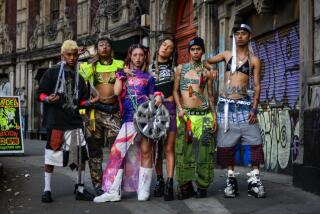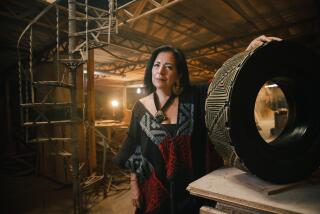Two artists — from L.A. and Tijuana — present their visions of the border at MASS MoCA
It is 1956. A queue of Mexican immigrants stands at a processing station in Texas, about to be admitted to the United States as part of the bracero guest worker program. They are naked, clothes in hand, waiting for a masked attendant to douse them with DDT, an insecticide whose use would be banned in the U.S. just 16 years later.
It was this scene of casual brutality that photographer Leonard Nadel captured on film in his documentary series devoted to migrant labor (and its many abuses) in the 1950s. In the caption he submitted with the picture, he notes that the men were treated by border authorities in “much the same manner and feeling used in handling livestock.”
The DDT shower was less a ritual of disease protection than a tool of humiliation.
Nadel’s indelible image serves as moving inspiration for a large-scale painting by Los Angeles artist Rafa Esparza that greets visitors to his solo installation at MASS MoCA, the contemporary art center in North Adams, Mass.
A thick slab of adobe serves as Esparza’s canvas. His image puts a tight focus on the workers. Their strong bodies, their bowed heads, brown skin blending into brown adobe as a white cloud of poison envelopes their faces.
Esparza’s installation, “staring at the sun,” on display through the end of the year, is one of two exhibitions at MASS MoCA that contend, in different ways, with the border and the ways in which it marks division but also generates resilience and symbioses.
One floor up and a building over is a survey of work by Tijuana artist Marcos Ramirez, who goes by the name “ERRE,” a show whose most visible component is a 120-foot corrugated metal sculpture titled “Of Fence,” from 2017, which evokes the rusty red look of the U.S.-Mexico border wall.
At one point, “Them and Us / Ellos y Nosotros,” as the show is titled, forces viewers to choose a path through the gallery — under signs titled “Us” and “Them.”
The two artists’ work could not be more different.
Esparza’s temple-like installation — in which he displays paintings on adobe in a gallery whose floor has also been covered in mud brick — is, to some degree, a meditation on material. Its brownness. Its earthiness. Its ephemerality. A material he uses as canvas to render portraits, not just of migrant workers but of friends and of family.
“Portraiture creates a legacy,” says the exhibition’s curator, Marco Antonio Flores. “The interesting thing is that for him to create portraits out of material that breaks and cracks, you think, what does that tell us about portraiture?”
ERRE’s show, which features an array of new and existing pieces, many produced throughout the artist’s career, reveals an artist deeply engaged in politics and policy — not to mention a mordant wit.
In a video titled “The Body of the Crime (The Black Suburban),” made in 2008, ERRE plays the victim of a cartel hit. He also plays policeman and forensic investigator. If he represents a society racked by violence at every level, he also represents that same society’s complicity. It’s a piece made more poignant by President Trump’s announcement this week that he wanted to designate the cartels terrorist groups.
Nearby sits a 2019 installation, “Orange Country,” which consists of orange prison jumpsuits in four sizes, including an infant’s onesie — an allusion to the continued detention of families and children at the U.S.-Mexico border. They serve as a stark, criminal justice counterpoint to Chris Burden’s oversized “L.A.P.D. Uniform” installation, in the collection of the Los Angeles County Museum of Art.
“ERRE is the perfect example of someone who lives with the border as a daily thing,” says MASS MoCA senior curator Susan Cross, “and not as a political abstraction.”
What unites Esparza and ERRE’s work is how they tackle the idea of the border as not simply a wall but as a punitive tool — the policies and procedures that are used to demonize and dehumanize. A DDT bath. A child in a cage.
As historian Greg Grandin notes in his recent book, “The End of the Myth: From the Frontier to the Border Wall in the Mind of America,” “The point isn’t to actually build ‘the wall’ but to constantly announce the building of the wall.”
On a more inspiring note, both exhibitions reveal the ways in which culture can circumvent any border put in its way.
One of Esparza’s paintings shows a figure pulling back a fence. Are they tearing it down or climbing over? It’s hard to say.
And his portraits of fellow artists — such as performance artist Sebastián Hernández and singer San Cha, both from L.A. — dwell not in victimhood but in graceful empowerment.
“These people are alive today,” says Flores, “and they are creating this artistic aesthetic legacy.”
One of ERRE’s best-known works is a two-headed wooden horse that rose to a height of 30 feet, which he installed at the Tijuana-San Ysidro border crossing in 1997.
“Toy-an Horse” had two legs planted in Mexico and two in the U.S., with one head facing north and the other to the south. It may have faced in different directions but its body was one. A political line may divide but the cultural body remains whole.
In the gallery, the piece is represented by a photomural showing the installation from the ’90s. But ERRE re-created the heads in wood, charred them and laid them on a bed of coal, in a yin-yang arrangement, in the middle of the gallery.
Together in life. Together in death. Like adobe, it will all one day crumble to dust.
Rafa Esparza: staring at the sun
Marcos Ramirez ERRE: "Them and Us / Ellos y Nosotros"
More to Read
The biggest entertainment stories
Get our big stories about Hollywood, film, television, music, arts, culture and more right in your inbox as soon as they publish.
You may occasionally receive promotional content from the Los Angeles Times.











